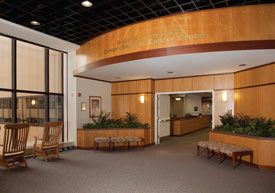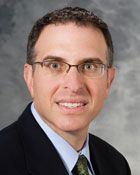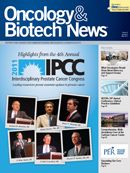Publication
Article
Oncology & Biotech News
University of Wisconsin Carbone Cancer Center: A Tradition of Comprehensive, Multidisciplinary Care
Author(s):
Currently, more than 250 physicians and scientists work in concert to provide state-of- the art diagnosis, treatment, and aftercare for the more than 20,000 patients seen each year at the UW hospitals, clinics, and affiliate clinical facilities

University of Wisconsin Carbone Cancer Center
Recognized throughout the nation as one of the leading innovators in cancer research, patient care, and community outreach, the University of Wisconsin Carbone Cancer Center (UWCCC) in Madison has its roots in the 1940 founding of the McArdle Laboratory for Cancer Research.
UWCCC is named for Paul P. Carbone, MD, who served as director of the facility (then called the UW Comprehensive Cancer Center) from 1976 until 1994. The Center is, today, Wisconsin’s only National Cancer Institutedesignated comprehensive cancer center, and operates as an integral part of the UW School of Medicine and Public Health.
Currently, more than 250 physicians and scientists work in concert to provide state-of- the art diagnosis, treatment, and aftercare for the more than 20,000 patients seen each year at the UW hospitals, clinics, and affiliate clinical facilities. The Center’s commitment to comprehensive and multidisciplinary care is perhaps best exemplified by the allinclusive range of services provided in its UW Health Breast Center, by a novel approach to treatment for pediatric neuroblastoma, and in the efforts of the Center’s gynecologic oncologists to preserve fertility after treatment for cervical and endometrial cancer.
UW Health Breast Center:
One-Stop Comprehensive Care
The UW Health Breast Center operates in collaboration with the UWCCC, bringing together clinicians from a range of specialties— including medical and surgical oncology, plastic and reconstructive surgery, radiology/imaging, and radiation oncology—all of whom work closely with UWCCC researchers. The UW Health Breast Center clinicians see nearly 600 new patients with breast cancer each year.
“From the moment they walk through the doors, our patients have access to everything they need under one roof,” said Lee Wilke, MD, a breast surgeon and the medical director of the UW Health Breast Center. “Patients get a complete plan for their care, from screening and prevention to diagnosis, treatment, and reconstruction.”
Two prime examples of this comprehensive, multidisciplinary approach to care are the Breast Center’s high-risk clinic and an innovative program that offers surgical patients a novel alternative to general anesthesia.
High-Risk Clinic
Described by Wilke as one of the flagships of the Breast Center, the 2-year-old High-Risk Breast Cancer Clinic—soon to be renamed the Prevention, Assessment, Tailored Health Screening (PATHS) Clinic—offers comprehensive services for “previvors,” specifically those at high risk for breast and/or ovarian cancer, primarily due to the BRCA1 and BRCA2 mutations. Patient services begin with tailored screening programs, which typically include twice-yearly physical exams, magnetic resonance imaging, and ovarian cancer screening. “These patients are living with a reality not experienced by most women: namely, that they will most likely contract breast or ovarian cancer over the course of their lifetime,” said Wilke. She explained that the screening program provided at the Center gives patients a good understanding of their true risk, teaches them what to look for, and enhances their sense of control. Patients who opt for a proactive approach also have access to prophylactic surgery.
Wilke noted that some women tend to be data-driven and want all the information they can get, while others do better with information that’s given gradually over time. For example, a new patient can opt to meet only with a nurse or social worker, or she can choose to meet with a surgeon to discuss prophylactic mastectomy on her first visit to the Clinic.
“We’re careful not to overwhelm our patients and, instead, give them what they need when they need it,” said Wilke.
If they desire, patients have access to nurses (all of whom are breast-certified and serve as patient educators) and nurse practitioners, social workers, genetic counselors, nutritionists, occupational therapists, and on-site medical oncologists, gynecologic oncologists, breast surgeons, reconstructive surgeons, and reproductive endocrinologists.
Paravertebral Anesthesia
Another impressive example of what can be accomplished when clinicians from multiple disciplines employ a team approach to care is a novel anesthesia protocol employing paravertebral blocks. This new approach gives UW Health Breast Center surgery patients the option of foregoing general anesthesia for all but the most major reconstruction surgeries. In addition to the obvious benefits of eliminating the need for general anesthesia, patients who undergo surgery via paravertebral block report greater satisfaction, less pain, and less use of pain medication, said Wilke.
“Some institutions, including UW, are looking at outcomes to see if there’s a benefit in that regard,” she said. “While difficult to duplicate, there has even been a report of improved survival among patients undergoing surgeries with paravertebral block rather than general anesthesia.”
The UW Health Breast Center has offered paravertebral anesthesia since May 2010 and was one of the first centers to do so. To date, approximately 190 breast surgeries have been performed with paravertebral anesthesia.
UWCCC Timeline
1940
1950
1960
1970
1940 — The University of Wisconsin-Madison’s McArdle Laboratory for Cancer Research is established as the nation’s first basic science cancer center at an academic institution, and one of the first in the world.
1946— McArdle receives its first multi-investigator National Cancer Institute (NCI) block grant, followed by 54 years of continuous NCI support.
1951— Charles Heidelberger, MD, synthesizes 5-fluorouracil.
1956— Van Potter, MD, elaborates on the biochemical basis for the clinical development of multidrug chemotherapy.
1960s— James Miller, MD, and Elizabeth Miller, MD, demonstrate that the metabolic activation of most chemical carcinogens to reactive electrophiles is required for their carcinogenic activity.
1973— The University of Wisconsin Comprehensive Cancer Center (UWCCC) is established.
1975— Howard Temin, MD, is awarded the Nobel Prize for his 1970 discovery of reverse transcriptase and its role in the life cycle of retroviruses.
1978— Paul P. Carbone, MD, is appointed director of the UWCCC, a position he holds through 1997.
Continued below
131I-MIBG Therapy for Neuroblastoma
The strong commitment to multidisciplinary care is also evident in a novel neuroblastoma treatment being offered at the UW’s American Family Children’s Hospital, in conjunction with the UWCCC.
Despite advances in treatments over the last 2 decades, neuroblastoma remains the fourth most commonly diagnosed childhood cancer in the United States, and the prognosis for those affected varies greatly, depending on the child’s age at diagnosis and the tumor stage and characteristics.

"From the moment they walk through the doors, our patients have access to everything they need under one roof."
—Lee Wilke, MD
While treatment can typically involve chemotherapy, surgery, radiation, and stem cell transplantation, combination therapy with radioactive iodine (131I) plus metaiodobenzylguanidine (MIBG) has been shown to be the most effective treatment for refractory or relapsed neuroblastoma, said Ken DeSantes, MD, pediatric oncologist and associate professor of pediatrics at the University of Wisconsin School of Medicine and Public Health. The 131I is chemically attached to the MIBG; this forms 131I-MIBG, which targets malignant cells and concentrates in the neuroblastoma tumor.
Almost all patients who undergo 131I-MIBG therapy experience symptom relief, with more energy and reduced pain. “What we’re seeing with this treatment is a significant improvement in quality of life,” said DeSantes. But despite its apparent benefits, 131I-MIBG for neuroblastoma is offered in only a handful of cancer centers around the country, including the UW American Family Children’s Hospital. “The program is a huge undertaking because of the radiation safety concerns, the logistics of administering a radiopharmaceutical agent to pediatric patients, and the many disciplines involved,” noted DeSantes, adding that it took 2 years of discussion and planning to get the program up and running.
Indeed, it was in 2007, when the new UW American Family Children’s Hospital was being built, that DeSantes and his colleagues recognized a unique opportunity to render the program feasible. “One of the major obstacles to offering this treatment is the lack of availability of a treatment area that provides the needed high level of safety and accommodates the needs of the patients, who remain in isolation for up to 5 days,” said DeSantes. “The plans to build the new Children’s Hospital provided us with a perfect opportunity to design and include a specially-designed treatment room that would meet these needs.” (See “The 131I-MIBG Treatment Room: Making the Best of a Difficult Situation.”)

"Rehearsals and mock codes are used to get the staff up to speed. While the treatment is extremely safe, we need to be prepared for all possible contingencies."
—Ken DeSantes, MD
The list of those required to deliver the treatment successfully includes a pediatric oncologist, 2 nurse practitioners, nuclear medicine and nuclear pharmacy personnel, pediatric intensive care staff, a radiation safety officer, a health physicist, a child life specialist, and a social worker. “All involved need to be educated in radiation safety, involving everything from preparing and cleaning the treatment room, to isolation procedures, infusion technique, and specialized sedation and monitoring,” explained DeSantes. “Rehearsals and mock codes are used to get the staff up to speed. While the treatment is extremely safe, we need to be prepared for all possible contingencies.”
It was August 2010 when the first patient, a 23-year-old from Minnesota, was treated with 131I-MIBG in the new treatment room. To date, an additional 5 such treatments have been performed. “The program is so unique that all our patients have come to us via word of mouth,” said DeSantes.
Other potential applications for 131I-MIBG are being investigated and include the treatment of pheochromocytoma. In addition, the Children’s Oncology Group is considering a phase III trial that would randomize newly diagnosed high-risk neuroblastoma patients to receive either chemotherapy followed by a conventional autologous stem cell transplant or chemotherapy followed by a transplant that incorporates 131I-MIBG into the pretransplant conditioning regimen.
UWCCC Timeline Continued
1990
2000
2010
1997 — UWCCC scientists develop TomoTherapy, enabling the targeting of cancer cells while preserving healthy cells and organs.
1999— The McArdle Laboratory for Cancer Research consolidates with the UWCCC, forming the UW Comprehensive Cancer Center.
2001-2006— The UWCCC is awarded numerous multi-investigator grants and launches its emphasis on multidisciplinary and translational research/medicine. External research and training support surpasses $135 million. Ground is broken on the Wisconsin Institutes for Medical Research at the UW School of Medicine and Public Health.
2002— The UW Health Breast Center opens its doors.
2004— David M. Kushner, MD, performs UWCCC’s first radical trachelectomy, preserving fertility after cervical cancer surgery.
2006— The UW Comprehensive Cancer Center is renamed the University of Wisconsin Carbone Cancer Center.
2007— UW’s American Family Children’s Hospital opens.
2010— A 23-year-old becomes the first neuroblastoma patient to undergo 131I-MIBG therapy in the Children’s Hospital’s new 131I-MIBG treatment area.
The 131I-MIBG Treatment Room: Making the Best of a Difficult Situation
Children and young adults treated with radioactive iodine (131I) plus metaiodobenzylguanidine (MIBG) for neuroblastoma are given a 90-minute IV infusion of 131I-MIBG, after which they have minimal contact with staff and family while the radiation is eliminated from the body.
The 131I-MIBG treatment suite at UW’s American Family Children’s Hospital is designed to provide staff, patients and patients’ families with the safest and most comfortable environment during treatment. The lead-lined floor, walls, ceiling, and doors effectively contain all radiation emanating from the patient, and in-room lead shields provide additional protection for family and staff. A sleep room next door is equipped with a closed-circuit television that allows parents to remain close and provide needed reassurance to their children, who can be as young as 3 years old. DVDs and video games can be operated from outside the treatment room to help combat a child’s boredom while also minimizing caregivers’ exposure to radiation. A specially designed system is employed to remove and dispose of radioactive urine.
“The idea is that incorporating the 131I-MIBG into treatment for newly diagnosed high-risk patients might improve cure rates,” said DeSantes, who noted that a feasibility study is currently underway.
In yet another extremely novel approach to neuroblastoma treatment, investigators at UW are looking at the use of 131I-MIBG to reduce tumor burden prior to haploidentical stem cell transplantation and natural killer cell infusions.

"While not without its adverse effects, high-dose progesterone does an excellent job of keeping the cancer from metastasizing, and a hysterectomy may be performed down the road, if needed."
—David M. Kushner, MD
Posttreatment Fertility
In another venue, UWCCC gynecologic oncology clinicians employ a multidisciplinary approach to further their commitment to providing the best possible outcomes with the least possible negative impact on patients’ lives. For some women, this is accomplished with minimally invasive procedures. For others, the commitment to providing treatment with the least impact on quality of life involves preserving fertility despite the need for cervical or endometrial cancer treatment.
Radical Trachelectomy
UWCCC gynecologic oncologists were among the first in the country to offer a uterus-sparing laparoscopic procedure followed by radical removal of the cervix for women who wish to maintain their fertility after cervical cancer treatment. The procedure, known as radical trachelectomy, is a viable alternative to radical hysterectomy, and investigators have reported not only excellent fertility rates but also full-term deliveries in the majority of women who do, indeed, become pregnant, said David M. Kushner, MD, UWCCC’s Gynecologic Oncology team leader.
Despite the recent push for cervical cancer treatments that preserve fertility, the use of radical trachelectomy has remained controversial in the United States, said Kushner. “The procedure only recently began to be taken seriously as positive outcomes from outside the United States have been reported and patient demand has increased,” he said. “Acceptance is growing as we incorporate robotics into the protocol, making the procedure even less invasive.”
Approximately 30 patients have undergone the procedure at UWCCC since it was first offered in 2004. Robotic-assisted radical trachelectomy has become the standard for many patients at UWCCC, but only a small number of other institutions offer this option.
“Fertility outcomes have been better than expected; in other words, similar to those in women who have not undergone the treatment,” said Kushner. He acknowledges a slightly increased miscarriage rate during mid-pregnancy but notes that the majority of women deliver at term.
Other Alternatives
A second approach to maintaining fertility focuses on keeping fertility as close to normal as possible throughout treatment, said Kushner, who notes that data are emerging on the safety of treatments that spare the uterus and employ hormone therapy in younger patients with early-stage gynecologic cancers. “The approach remains controversial but we’re learning that it is, indeed, safe,” he said. “While not without its adverse effects, high-dose progesterone does an excellent job of keeping the cancer from metastasizing, and a hysterectomy may be performed down the road, if needed.”
Finally, said Kushner, advanced technologies with a proven track record for noncancer-related infertility—including egg harvest and freezing, embryo freezing, surrogacy, and ovarian transposition—are now being used to give women the option of starting or adding to their families despite the need for cancer treatment.
Kushner described the commitment to interdisciplinary teamwork as a common thread that weaves through all of these endeavors, and notes that this commitment is shared by a diverse group that includes gynecologic oncologists, radiation oncologists, fertility specialists, cancer psychologists, social workers, nutritionists, and physicians specializing in alternative medicine. Information flows in all directions in tumor board conferences and throughout the course of treatment and followup, and clinicians consistently integrate the input of UWCCC pathologists and researchers.
“The first concern for patients diagnosed with gynecologic cancer is, of course, survival,” said Kushner. “But once a woman realizes that survival doesn’t necessarily need to come at the expense of a new or growing family, she can pursue her treatment with hope for a future that includes the dreams she had before her diagnosis.”
Laura Bruck is a Cleveland, Ohio-based freelance writer and editor who has specialized in healthcare reporting since 1987.





























